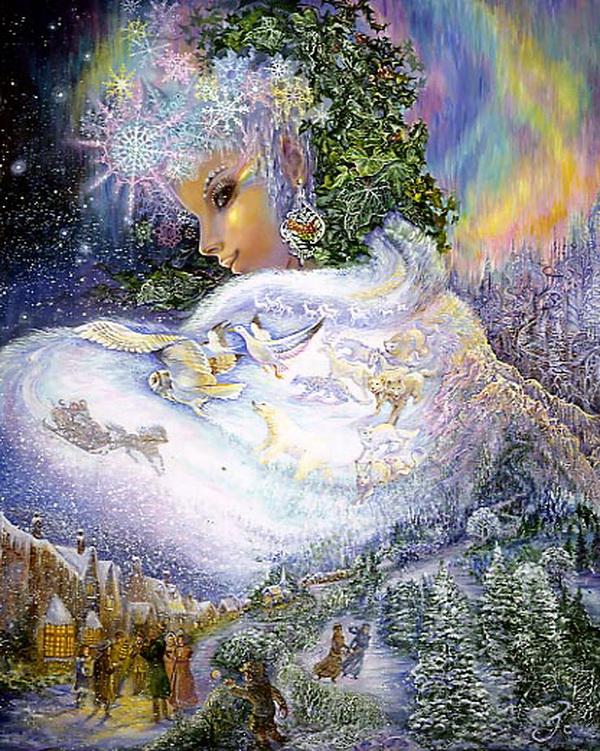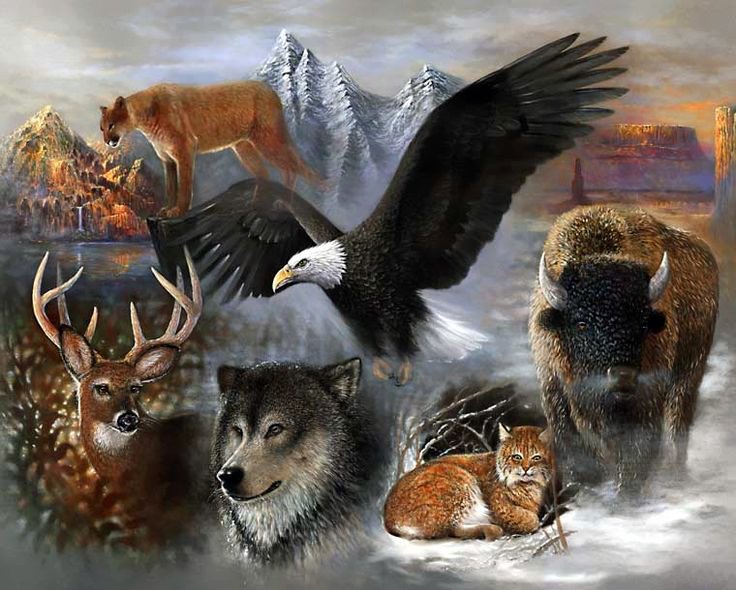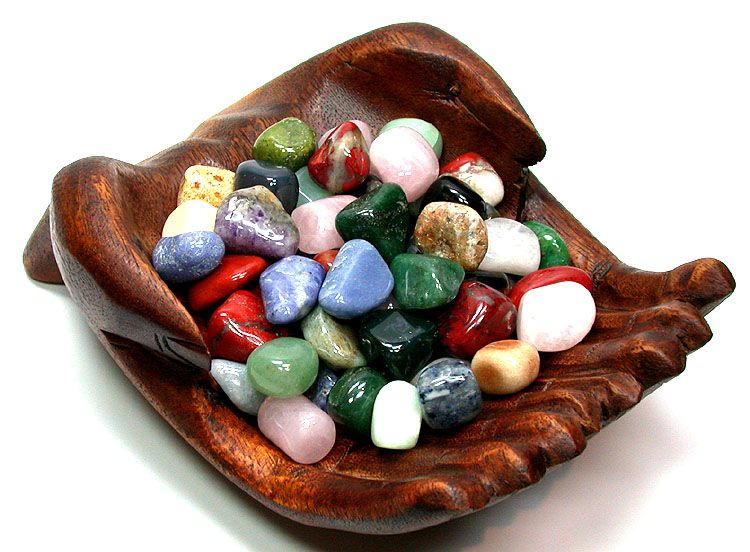Yule
- Details
- Written by CrystalWind.ca
- Views: 12123

Yule Ritual Celebrated on the Winter Solstice, around December 21 each year.
One of the four minor Sabbats, Yule celebrates the rebirth of the Sun, the Sun God, and honors the Horned God.
Yule is the longest night of the year, when balance is suspended and then gives way to the coming light. It is a time to look on the past year's achievements and to celebrate with family and friends. In ancient times, the Winter Solstice corresponded with the Roman Saturnalia (Dec. 17-24), pagan fertility rites, and various rites of Sun worship. This day is the official first day of winter. The Goddess gives birth to the Sun Child and hope for new light is born. The origins of most of the Christian Christmas traditions come from the Pagan Yule celebration, such as the Christmas tree, the colors red and green and gift giving. Yule is also known as the Winter Solstice, Midwinter, Alban Arthan, Finn's Day, Festival of Sol, Yuletide, Great Day of the Cauldron, and Festival of Growth.
At the Winter Solstice, the two God-themes of the year's cycle coincide. Yule, which according to the Venerable Bede, comes from the Norse Iul meaning "wheel", marks the vanquishing of the Holly King (Dionysus), God of the Waning Year, by the Oak King (Apollo), God of the Waxing Year. The Goddess, who was Death-in-Life at Midsummer, now shows her Life-in-Death aspect; for although at this season she is the "leperous-white lady", the Queen of the cold Darkness, yet this is her moment for giving birth to the Child of Promise, the Son-Lover who will re-fertilize her and bring back light and warmth to her kingdom.
An extraordinarily persistent version of the Holly King/Oak King theme at the Winter Solstice is the ritual hunting and killing of the wren - a folklore tradition found as far apart in time and space as ancient Greece and Rome and today's British Isles. The wren, "little king" of the Waning Year, is killed by his counterpart, the robin redbreast, who finds him hiding in as ivy bush (or sometimes in Ireland in a holly bush, as befits the Holly King). The robin's tree is the birch, which follows the Winter Solstice in the Celtic Tree calendar. In the acted-out ritual, men hunted and killed the wren with birch rods.
As for traditions, the modern personification of the Christmas Spirit known as Santa Claus was at one time the pagan God of Yule. To the Scandinavians, Woden was once known as "Christ on the Wheel", an ancient Norse title for the Sun God who was reborn at the time of the Winter Solstice. St. Nicholas, in early folklore, rode not a reindeer, but a white horse through the sky - like Woden.
The burning of the Yule Log stems from the old custom of the Yule Bonfire that was burned to give life and power to the Sun, which was thought to be reborn at the Winter Solstice. In later times, the outdoor bonfire custom was replaced by the indoor burning of log and red candles etched with carvings of solar designs and other magical symbols. As the Oak Tree was considered to be the Cosmic Tree of Life by the ancient Druids, the Yule Log is traditionally Oak. Some Wiccan traditions use a Pine Yule Log to symbolize the dying God Dionysus.
Mistletoe was considered very magical by the Druids, who called it the "Golden Bough". They believed it possessed great healing powers and gave mortal men access to the underworld. The living plant, which is actually a parasitic shrub with leathery evergreen leaves and waxy white berries, was at one time thought of as the genitalia of the great God Zeus, whose sacred tree is the Oak. The phallic significance of mistletoe stems from the idea that its white berries were drops of the God's Divine Semen in contrast to the red berries of the Holly, which were equated with the Sacred Menstrual Blood of the Goddess. The life-giving essence which mistletoe suggests provides a symbolic divine substance and a sense of immortality to those who hang it at Yuletide. In ancient times, ecstatic sexual orgies frequently accompanied the rites of the Oak King; in modern times, however, the custom of kissing under the mistletoe is all that remains.
The relatively modern tradition of decorating the Christmas tree is a custom that evolved from the silver fir and pine groves associated with the Great Mother Goddess. The lights and ornaments hung on the tree as decoration are actually symbols of the Sun, Moon, and Stars as they appear in the Cosmic Tree of Life. They also represent departed souls who are remembered at the end of the year. Sacred presents (which evolved into modern day Christmas gifts) were also hung on the tree as offerings to various deities such as Dionysus.
There is an ancient Egyptian ritual involving Isis and Osiris, and his brother/enemy Set, who kills Osiris and is driven away by the shaking of Isis' sistrum, to bring about Osiris' rebirth. For the festival, people decorated the outside of their houses with oil-lamps that burned all night. At midnight, the priests emerged from an inner shrine crying, "The Virgin has brought forth! The light is waxing!" and showing the image of a baby to the worshipers. Osiris and Horus, his son/other-self, represent at the same time the solar and vegetation God-aspects; Horus is both the Sun reborn (the Greeks identified him with Apollo) and "Lord of the Crops". The lamps burning all night on the eve on Midwinter survive, in Ireland and elsewhere, as the single candle burning in the window on Christmas Eve, lit by the youngest in the house, and as the modern lights that are strung on the outside of houses.
Placing cakes in the boughs of the oldest apple trees in the orchard and pouring on cider, as a libation was an old pagan Yuletide custom practiced in England, and known as "Wassailing the Orchard Trees". It was said that the cider was a substitute for the human or animal blood offered in primitive times as part of a Winter Solstice Fertility Rite. After offering a toast to the health of the apple trees and giving thanks to them for producing fruit, the farmers would then enjoin the trees continue producing abundance.
Dreams
One ancient belief is that dreams during the Twelve Nights predict the events in one's life for the coming year. An interesting activity would be to keep a log of one's dreams for each of the Twelve Nights.
Gift Giving
The tradition of gift giving goes back to Heathen times when gifts were exchanged throughout the Yuletide and not only on one day of the tide. Therefore, it is fitting that Heathens do this as well. Gifts need not be expensive and handmade gifts are often better than something purchased at a store. Ideal gifts are those relating to our religion, books, ritual gear, art, tapes, and of course drinking horns.
Holly, Ivy, and Yule Decor
At Yuletide, the Elder Heathens decorated their homes with ivy, holly, and boughs of evergreens. Ribbons were also used and the entire home covered with garlands and wreathes. Modern Heathen should do not less in an attempt to capture the Yuletide spirit. Below are three of the more common house decorations.
Yule Tree: The tradition of the Yule tree comes from Germany. Originally, it is believed the trees were decorated outside and gifts left for the land wights. This custom can still be observed in other parts of Northern Europe. With Christianity, the trees were brought inside to hide from the church. Modern Heathen trees can be decorated with Heathen symbols as well as the commercial lights, glitter, and ornaments. If one wants they can decorate a tree outside instead as the Heathens of old did.
Yule Wreaths: Modern tradition uses a Yule wreath at the Mothers' Night symbol as an oath ring. This wreath is oathed upon as well as wished upon, and then burned at the Twelfth Night blot. Therefore these wreathes are best made out of natural substances such as cedar branches. Other wreathes can be used as decorations around the house.
Lights: In the more northern countries, Lucy Day, which was a festival of lights, is celebrated and seems an ancient holiday in connection with Yule. Candles, torches, and other forms of light were left burning to light up the night skies. Today we can use electric lights for the same purpose.
Morris Dancing
Morris dancing, particularly the variety consisting of swordplay also took place during the Yuletide. Morris dancing to quote Linetwigle of the Ealdriht in her paper, Dance in Northern Tradition consisted of "stamping, leaping and hopping, rapping of swords or planting rods against the ground (these denoting a connection to fertility of the land), and the wearing of bells, plus a plethora of regional variations." Morris dancing also consisted of blackening of the faces (as did often mumming and hoodening) to either scare off evil spirits, or to mock the Wild Hunt.
Mumming
Something more practical for Heathens than Morris Dancing is mumming. Mummer plays take place in all of England, usually in pubs. All of the plays consist of five to twelve cast members and follow the same basic plot. 1) A hero returns from a distant land. 2) The hero is challenged and killed. 3) A doctor is called and revives the hero. 4) All hostilities are ceased. Some see this as a ritual reenactment of the birth and death of a sun god. This is highly unlikely, as Heathen lore seems to have preserved no myths of this particular type. More likely, the plays were for entertainment value alone, and if anything to celebrate the healing powers of the gods, particularly Woden as a healer, and to educate that Yuletide is a time for kinship and wishes that come true. Day 8 of the Yule rites presented here consists of a Mummer Play.
Sword Dancing
Another form of dance performed at Yuletide besides the Morris Dances were the Sword Dances. These were at one time performed with the long sword and seem to be quite ancient. Most of the dances consist of a procession and the clashing and leaping of swords as well as the formation of various patterns with the swords. Often the dance ends with a mock death and revival by a "doctor" as with the Mummer Plays.
Wassailing
The wassailing of Victorian times resembled caroling more than it did its earlier counterpart, and is the form most are familiar with. Ancient wassailing consisted of making the drink wassail, originally mulled ale, curds, apples, and sometimes nuts. A group of wassailers would then go out with bowls filled with wassail from house to house and wassail the apple and cherry trees with songs and loud noises to ensure a good crop from the orchards the next year. A few wassailing songs survive, but these seem to be of a later variety.
Yule Log
The Yule log has not survived into modern celebrations for the most part, and for most modern Heathens would be difficult to do without a fireplace or wood burning stove. You may therefore wish to set up a symbolic Yule log. You can carve it with wishes for the New Year, garland it, do what you wish. If you have a place you can burn it outside during Yuletide, you may wish to do so.
Traditionally, the Yule log was brought in on Mothers' Night, it was then set ablaze and hoped to burn all Twelve Nights (remember this log was nearly an entire tree to be burned in the long pits of a long house). Different areas had different customs concerning the Yule log. Everywhere the log was garlanded and decorated with ribbons before the procession to the longhouse. The procession was, as most procession during the holidays, a joyous one. Once burning no one could squint in the presence of the log, nor were barefooted women allowed around it. In Yorkshire, England, they practiced what is called mumping or gooding. Children would go begging and singing from house to house as the log was brought in. In other areas, the children were allowed to wassail the log the first night and drink to it.
Correspondences
Symbolism: Rebirth of the Sun, hope born amidst the darkness
Symbols: evergreen trees, Yule log, holly, eight-spoked wheel, wreaths, spinning wheels.
Foods: roasted turkey, nuts, apples, caraway rolls, dried fruit, fruitcakes, gingerbread men, mulled wine, eggnog, wassail.
Plants & herbs: holly, mistletoe, evergreen, poinsettia, bay, pine, ginger, myrrh, valerian, cinnamon, nutmeg, oak, orange.
Incense and oils: rosemary, myrrh, nutmeg, saffron, cedar, pine, wintergreen, ginger, bayberry.
Colors: red, green, white, gold.
Stones: Bloodstones, ruby, garnet, cat's eye.
Animals and mythical beasts: stags, squirrels, wren/robin, phoenix, trolls, memecolion.
Some appropriate Goddesses: Albina (Tuscan), Angerona (Roman), Anna Perenna (Roman), Fortuna (Roman), Gaia (Greek), Grian (Irish), Heket (Egyptian), Isis (Egyptian), Kefa (Egyptian), Lucina (Roman), Persephone (Greek), Rhiannon (Welsh)
Some appropriate Gods: all reborn and Sun Gods; Apollo (Greco-Roman), Attis (Anatolian), Balder (Norse), Cronos (Greek), Helios (Greek), Hyperion (Greek), Janus (Roman), Lugh (Irish), Oak/Holly King (Anglo-Celtic), Odin (Norse), Osiris (Egyptian), Ra (Egyptian), Saturn (Roman), Sol (Roman)
Decorations: mistletoe, holly, small Yule log, strings of colored lights, Yule/Christmas cards, a candle in the shape of Kris Kringle, homemade wreath, presents wrapped in colorful paper.
Traditional activities: decorating the Yule tree, exchanging gifts, storytelling, making wreaths, throwing holiday parties, sending greetings.
Spell/ritual work: peace, harmony, love, increased happiness, a healthier planet.
Midwinter's Eve: Yule
by Mike Nichols
Our Christian friends are often quite surprised at how enthusiastically we Pagans celebrate the 'Christmas' season. Even though we prefer to use the word 'Yule', and our celebrations may peak a few days before the 25th, we nonetheless follow many of the traditional customs of the season: decorated trees, carolling, presents, Yule logs, and mistletoe. We might even go so far as putting up a 'Nativity set', though for us the three central characters are likely to be interpreted as Mother Nature, Father Time, and the Baby Sun-God. None of this will come as a surprise to anyone who knows the true history of the holiday, of course.
In fact, if truth be known, the holiday of Christmas has always been more Pagan than Christian, with its associations of Nordic divination, Celtic fertility rites, and Roman Mithraism. That is why John Calvin and other leaders of the Reformation abhorred it; why the Puritans refused to acknowledge it, much less celebrate it (to them, no day of the year could be more holy than the Sabbath), and why it was even made illegal in Boston! The holiday was already too closely associated with the birth of older Pagan gods and heroes. And many of them (like Oedipus, Theseus, Hercules, Perseus, Jason, Dionysus, Apollo, Mithra, Horus and even Arthur) possessed a narrative of birth, death, and resurrection that was uncomfortably close to that of Jesus. And to make matters worse, many of them pre-dated the Christian Savior.
Ultimately, of course, the holiday is rooted deeply in the cycle of the year. It is the Winter Solstice that is being celebrated, seed-time of the year, the longest night and shortest day. It is the birthday of the new Sun King, the Son of God -- by whatever name you choose to call him. On this darkest of nights, the Goddess becomes the Great Mother and once again gives birth. And it makes perfect poetic sense that on the longest night of the winter, 'the dark night of our souls', there springs the new spark of hope, the Sacred Fire, the Light of the World, the Coel Coeth.
That is why Pagans have as much right to claim this holiday as Christians. Perhaps even more so, as the Christians were rather late in lying claim to it, and tried more than once to reject it. There had been a tradition in the West that Mary bore the child Jesus on the twenty-fifth day, but no one could seem to decide on the month. Finally, in 320 C.E., the Catholic Fathers in Rome decided to make it December, in an effort to co-opt the Mithraic celebration of the Romans and the Yule celebrations of the Celts and Saxons.
There was never much pretense that the date they finally chose was historically accurate. Shepherds just don't 'tend their flocks by night' in the high pastures in the dead of winter! But if one wishes to use the New Testament as historical evidence, this reference may point to sometime in the spring as the time of Jesus' birth. This is because the lambing season occurs in the spring and that is the only time when shepherds are likely to 'watch their flocks by night' -- to make sure the lambing goes well. Knowing this, the Eastern half of the Church continued to reject December 25, preferring a 'movable date' fixed by their astrologers according to the moon.
Thus, despite its shaky start (for over three centuries, no one knew when Jesus was supposed to have been born!), December 25 finally began to catch on. By 529, it was a civic holiday, and all work or public business (except that of cooks, bakers, or any that contributed to the delight of the holiday) was prohibited by the Emperor Justinian. In 563, the Council of Braga forbade fasting on Christmas Day, and four years later the Council of Tours proclaimed the twelve days from December 25 to Epiphany as a sacred, festive season. This last point is perhaps the hardest to impress upon the modern reader, who is lucky to get a single day off work. Christmas, in the Middle Ages, was not a single day, but rather a period of twelve days, from December 25 to January 6. The Twelve Days of Christmas, in fact. It is certainly lamentable that the modern world has abandoned this approach, along with the popular Twelfth Night celebrations.
Of course, the Christian version of the holiday spread to many countries no faster than Christianity itself, which means that 'Christmas' wasn't celebrated in Ireland until the late fifth century; in England, Switzerland, and Austria until the seventh; in Germany until the eighth; and in the Slavic lands until the ninth and tenth. Not that these countries lacked their own mid-winter celebrations of Yuletide. Long before the world had heard of Jesus, Pagans had been observing the season by bringing in the Yule log, wishing on it, and lighting it from the remains of last year's log. Riddles were posed and answered, magic and rituals were practiced, wild boars were sacrificed and consumed along with large quantities of liquor, corn dollies were carried from house to house while caroling, fertility rites were practiced (girls standing under a sprig of mistletoe were subject to a bit more than a kiss), and divinations were cast for the coming Spring. Many of these Pagan customs, in an appropriately watered-down form, have entered the mainstream of Christian celebration, though most celebrants do not realize (or do not mention it, if they do) their origins.
For modern Witches, Yule (from the Anglo-Saxon 'Yula', meaning 'wheel' of the year) is usually celebrated on the actual Winter Solstice, which may vary by a few days, though it usually occurs on or around December 21st. It is a Lesser Sabbat or Lower Holiday in the modern Pagan calendar, one of the four quarter days of the year, but a very important one. Pagan customs are still enthusiastically followed. Once, the Yule log had been the center of the celebration. It was lighted on the eve of the solstice (it should light on the first try) and must be kept burning for twelve hours, for good luck. It should be made of ash. Later, the Yule tree replaced the Yule log but, instead of burning it, burning candles were placed on it. In Christianity, Protestants might claim that Martin Luther invented the custom, and Catholics might grant St. Boniface the honor, but the custom can demonstrably be traced back through the Roman Saturnalia all the way to ancient Egypt. Needless to say, such a tree should be cut down rather than purchased, and should be disposed of by burning, the proper way to dispatch any sacred object.
Along with the evergreen, the holly and the ivy and the mistletoe were important plants of the season, all symbolizing fertility and everlasting life. Mistletoe was especially venerated by the Celtic Druids, who cut it with a golden sickle on the sixth night of the moon, and believed it to be an aphrodisiac. (Magically -- not medicinally! It's highly toxic!) But aphrodisiacs must have been the smallest part of the Yuletide menu in ancient times, as contemporary reports indicate that the tables fairly creaked under the strain of every type of good food. And drink! The most popular of which was the 'wassail cup' deriving its name from the Anglo-Saxon term 'waes hael' (be whole or hale).
Medieval Christmas folklore seems endless: that animals will all kneel down as the Holy Night arrives, that bees hum the '100th psalm' on Christmas Eve, that a windy Christmas will bring good luck, that a person born on Christmas Day can see the Little People, that a cricket on the hearth brings good luck, that if one opens all the doors of the house at midnight all the evil spirits will depart, that you will have one lucky month for each Christmas pudding you sample, that the tree must be taken down by Twelfth Night or bad luck is sure to follow, that 'if Christmas on a Sunday be, a windy winter we shall see', that 'hours of sun on Christmas Day, so many frosts in the month of May', that one can use the Twelve Days of Christmas to predict the weather for each of the twelve months of the coming year, and so on.
Remembering that most Christmas customs are ultimately based upon older Pagan customs, it only remains for modern Pagans to reclaim their lost traditions. In doing so, we can share many common customs with our Christian friends, albeit with a slightly different interpretation. And thus we all share in the beauty of this most magical of seasons, when the Mother Goddess once again gives birth to the baby Sun God and sets the wheel in motion again. To conclude with a long-overdue paraphrase, 'Goddess bless us, every one!'
Image: Joesphine Wall
The original article is copyrighted by the author listed above and is posted on CrystalWind.ca © 2011 - 2025. All rights reserved. Unauthorized reproduction, distribution, or use of this content, in whole or in part, is strictly prohibited without prior written permission. Discover the wisdom of CrystalWind.ca! Since 2008, we've been dedicated to awakening, enlightenment, and self-help to empower your spiritual journey. Dive in and grow with us—your next step awaits! #CrystalWind #SpiritualJourney
Liked this article? Dive deeper into personal growth and wellness! Check out CrystalWind.ca for spiritual wisdom or explore AromaWorx.ca for natural well-being tips. Spread the positivity—share this with friends on their happiness journey!
Let’s Chat! Drop Your Thoughts Below! ![]()
Latest Articles

Imagine a world of inspiration and healing, free for all—made possible by YOU!
Donate Now—Ignite the Magic at CrystalWind.ca!

Epilepsy - Finding A Cure
Your donation can make a difference!
Help us find a cure – donate now!
Unlock Your Light: Join Lightworkers Worldwide on CrystalWind.ca!
Articles: Wiccan Wheel of the Year
Follow Us!
Featured This Month
Crystals for Virgo
As the warmth of summer begins to soften into the crispness of autumn, the Sun... Read more
The Vine: September 2nd - September 29th
The Autumnal Equinox ( Alban Elfed ) Celtic Symbol : The White Swan Read more
Peridot: The Healer's Stone
Peridot has been used as a Power Stone for centuries. Peridot fosters emotio... Read more
Mabon in Modern Times: Fresh Takes on the Au…
The Mabon season begins somewhere around the 21st-22nd of September and cont... Read more
Sweet Violet
Sweet Violet Faithfulness and modesty. “I will always be true to you.” Helps... Read more
Mabon Magic: Ideas For Fall Decoration And R…
Welcome (almost!) to Fall! We’re turning the Great Wheel once again, toward ... Read more
Sun in Virgo
An Overview of Sun Sign Characteristics for Virgo Virgo is guided by Mercur... Read more
Watermelon Tourmaline
Synonym: Rainbow Tourmaline The watermelon tourmaline is a rare variety t... Read more
Virgo Mythology
The Virgo Myth In all of constellation mythology, few legends are as misund... Read more












































